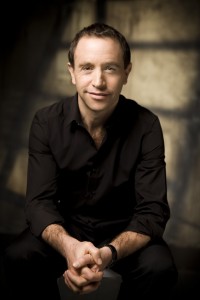UTAH SYMPHONY, Abravanel Hall, March 7; additional performance 8 p.m. March 8, tickets at 801-355-2787, 888-451-2787 or www.utahsymphony.org
Friday night the Utah Symphony performed an intriguing program under the energetic baton of guest conductor Mark Wigglesworth. The program comprised three distinctly different symphonies composed approximately a 100 years apart at the ends of the 18th, 19th and 20th centuries, respectively. As such, the audience had an insightful glimpse into the full evolution of the symphony — both in form and esthetic possibilities — from its early days up to very recent times. The Utah Symphony musicians were predictably excellent, and one sensed an affinity with Maestro Wigglesworth’s tastefully dynamic style.
The only bone I have to pick with his effervescent Mozart Haffner Symphony was the all-too-apparent imbalance between the brass and the strings, especially the first violins. Why is it that conductors insist upon using a skeleton crew of string players when half the section is schmoozing in the lounge waiting to be called for the next piece? Yes, we all know that in the 18th century orchestras were smaller. But so were concert halls, and it also is pretty clear that composers in those days — including Mozart — when given their druthers would have given their eye teeth to squeeze as many musicians on the stage as would fit. Furthermore, if you’re going to do away other performance conventions of the time, including declining to take Mozart’s repeats (in the Andante, which Maestro Wigglesworth should have; after all, he did choose to take the big repeat in the first movement of the Dvorák, which he needn’t have), then why not add adequate meat to the bones of the string sound? There’s a point at which scholarship should be subservient to the performance — to my ear, that point is when you can’t hear the tune. Having a fuller section — and perhaps a little more precise direction from the podium — might also have helped the last movement Presto, which should have been scintillating but came off a bit ragged.
The Symphony No. 4 by Witold Lutoslawski — brooding, dense, cataclysmic at times, a stark contrast to the Mozart — was perhaps the most compellingly performed piece of the evening. Lutoslawski’s voice, while remaining singular, in some ways echoes his East European antecedents in Béla Bartók, and yes, even to some degree, Dvorák. All three were master orchestrators and, as grand as their orchestral vision was, composed with clarity of line and carefully considered sense of structure. There were excellent solos by principal clarinetist Tad Calcara to start the journey, and later by pianist Jason Hardink and concertmaster Ralph Matson. Lutoslawski is not yet a household name in American concert halls, but bravo to Maestro Wigglesworth and the Utah Symphony for taking a giant step in that direction.
What can one say (or play) about the Dvorák Symphony From the New World that hasn’t already been said (or played)? The piece is like everyone’s favorite uncle who never wears out his welcome no matter how many times he comes to visit and tells the same story. Even when it gets a little frayed around the edges, as it did on a few occasions last night, it makes the visit all the more endearing. Almost all of the performance, though, was wonderfully done. Kudos to English hornist Lissa Stolz who, following in the footsteps of her predecessor Holly Gornik, played the famous solo in the Largo with touching beauty. Also a shout out to the string bass section for nailing the final chord of that movement, both for intonation and balance (no easy feat), and to oft-overlooked sensitive triangle playing in the Scherzo. All in all, the great tunes and rhythms had wonderful energy, all the tempos worked, and the climaxes were well-timed and dramatic. What’s not to love?

